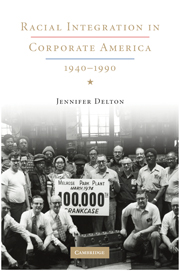Book contents
- Frontmatter
- Contents
- List of Tables
- Introduction
- PART I COLOR-BLIND GROUNDWORK, 1940–1961
- PART II COLOR-CONSCIOUS ASCENDANCY, 1961–1990
- 6 How Compliance Became Voluntarism
- 7 The National Association of Manufacturers Helps Out
- 8 Changing Hiring Criteria
- 9 The Du Pont Company's Affirmative Action Efforts
- Epilogue: From Affirmative Action to Diversity
- Statistical Tables
- Bibliography
- Acknowledgments
- Index
- References
8 - Changing Hiring Criteria
Published online by Cambridge University Press: 05 June 2012
- Frontmatter
- Contents
- List of Tables
- Introduction
- PART I COLOR-BLIND GROUNDWORK, 1940–1961
- PART II COLOR-CONSCIOUS ASCENDANCY, 1961–1990
- 6 How Compliance Became Voluntarism
- 7 The National Association of Manufacturers Helps Out
- 8 Changing Hiring Criteria
- 9 The Du Pont Company's Affirmative Action Efforts
- Epilogue: From Affirmative Action to Diversity
- Statistical Tables
- Bibliography
- Acknowledgments
- Index
- References
Summary
We have a growing conviction that we should not restrict our hiring entirely to qualified applicants, even if the supply of qualified applicants permitted us to do so.
Charles Luce, Chairman of the Board, Consolidated Edison, 1969Finally, we just tore up the regular [application] form and devised a very simple one. You want a job, describe why you want it.
William Norris, founder and CEO of Control Data CorporationIn the late 1960s, American cities were in a state of crisis marked by racial unrest, high unemployment, and urban decay. The Kerner Commission on Civil Disorders blamed the crisis on white racism and recommended the creation of 2 million new jobs, comprehensive school desegregation, a massive job-training program, and a guaranteed income. The heads of major corporations tried to rally their peers to regain control over the situation, to assert the leadership of the so-called private sector. In the words of a senior vice-president of First National City Bank of New York, “Government has demonstrated its inability to deal with many of these problems effectively and it is imperative that the talents and experience of business be brought to bear upon them.” Although many within the business community rejected the idea that businesses should become agents of reform, others embraced the role. In a short-lived burst of social responsibility, employers took on the job of training what were termed variously “the hard-core unemployed,” the “unemployable,” or “the disadvantaged,” the majority of whom were imagined as black.
- Type
- Chapter
- Information
- Racial Integration in Corporate America, 1940–1990 , pp. 225 - 254Publisher: Cambridge University PressPrint publication year: 2009



